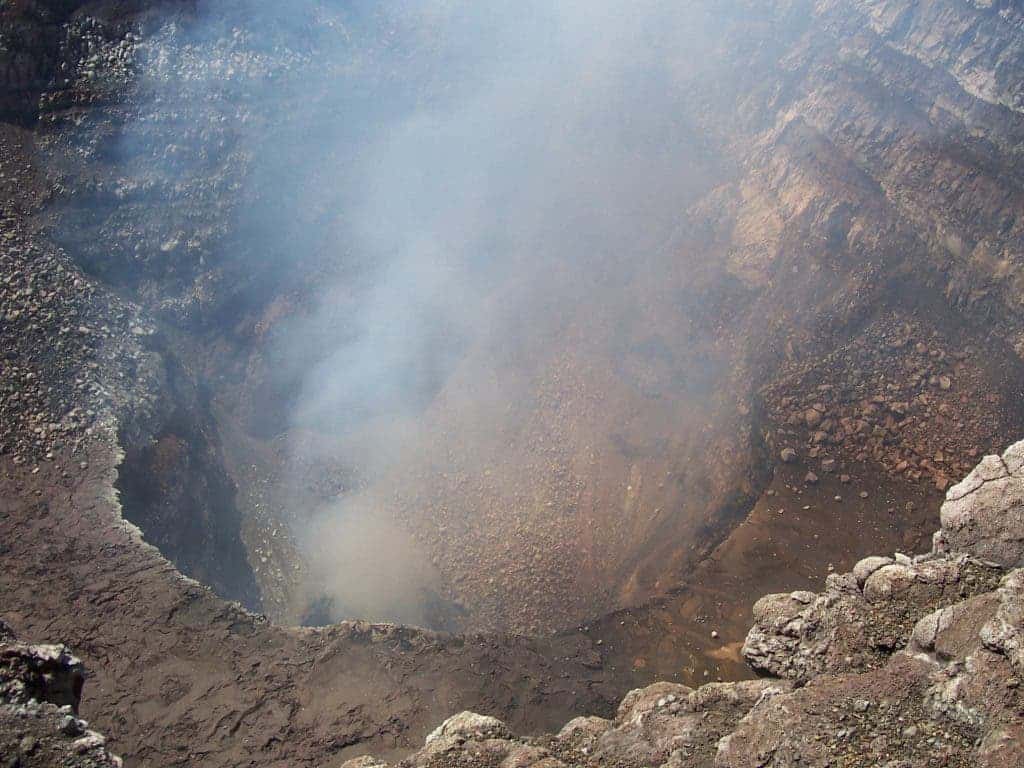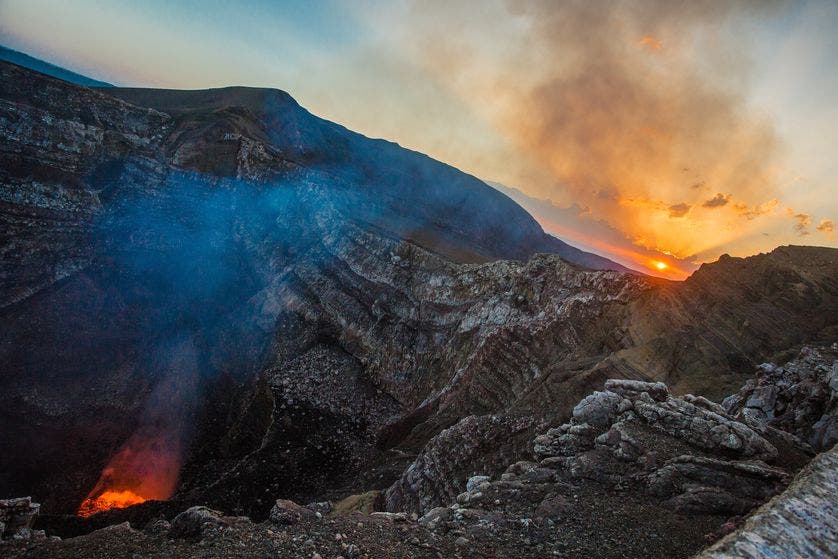A colony of bees has been discovered nesting in some of the most inhospitable terrain you could imagine: on the lip of an active shield volcano in Nicaragua. The colony fights heat and acidic gases while feeding almost exclusively on a species of wildflower that adapted to survive to volcanic acid rain.

Image credits Wikimedia via user belemnita.
Life blossoms in the most unexpected places, but the mouth of an active volcano seems a tad extreme. And yet, among the scorching desolate landscape dotted with sloshing pits of lava and plumes of acidic gases of the Masaya volcano in Nicaragua, a group of 1000 or 2000 Anthophora squammulosa lives, eats and breeds in seeming bliss. This solitary species of ground-nesting bee is native to parts of North and Central America. The females dig holes into the ground in which they lay their eggs, then look for pollen and nectar for the developing larva to feed on.
But this usually takes place in nice, comfortable environments that have zero lava. This discovery in fact marks the first ever known group of bees, of any species, that can survive in an environment as harsh as an active volcano cone. The team that discovered them, led by ecologist Hilary Erenler from the University of Northampton in the U.K., writes that the bees are nesting “within meters of an active volcanic crater.” Female bees dig tunnels into volcanic ash to lay their eggs — a habitat so inhospitable the study describes the insects as extremophiles.
“The nest location is exposed to continuous, strongly acidic gas emissions,” according to Erenler and her co-authors, “and sporadic vent-clearing episodes that blanket the surrounding area with ash and tephra.”
Volcanic ash nesting has previously been reported in a few other bees but with a key difference, the authors say. Those reports came from exposed roadsides in Guatemala, about 6 kilometers (3.7 miles) from the nearest volcanic vent. This population of A. squammulosa, on the other hand, nests just a few meters away from a volcanic crater.
Masaya is a 635-meter (2,080-foot) shield volcano known for its frequent eruptions. The bees nest almost exclusively in a narrow patch of ash by the crater Santiago, “one of the world’s strongest sources of sulfur dioxide” (SO2), the team notes. The gases are highly acidic, “creating a clearly defined ‘kill zone’ under which vegetation is either entirely suppressed or partly damaged, depending on proximity to the source.”
Sulfur dioxide in concentrations as low as 0.28 parts per million (ppm) is known to cause a variety of issues for bees, the team adds, such as slowing the development of larvae, lowering the survival rate of pupae, interfering with foraging and lowering the lifespan of adults. How the bees manage to live around Santiago, where SO2 levels range from 0.79 to 2.73 ppm, more than 10 times the dangerous level, is anyone’s guess at this point.
But wait, it gets even worse

Image credits Jorge Mejía Peralta/Flickr
The bees have to contend with volcanic ash, which under the microscope looks like a thousand small glass blades, as I can attest from experience. A study of Costa Rica ash eruptions performed in 1975 showed that the ash sandblasts the insects, wearing down their exoskeletons. It also contaminates pollen and nectar, which when ingested caused physical and chemical damage to insects. Then, there’s the obvious danger posed by a volcanic eruption, which could single-highhandedly wipe out the entire population of bees.
Since there’s so much SO2 in the air around Masaya, any plant life that sprouts in its kill zone is destroyed by acid rain. But bees needs flowers to survive, and the researchers wanted to find out where the group gets its nectar. They searched for flowers within 725 meters (2,378 feet) of the nest area, the rough distance your average foraging bee travels in search for flowers. The team also snatched up 10 bees returning to their nests, swabbing pollen from their legs.
The team identified 14 plant species in their search, but the pollen they recovered hold another surprise for them: more than 99 percent of the pollen found in those 10 samples belonged to a single species of wildflower, Melanthera nivea. A hardy member of the daisy family, M. nivea ranges from the Southeastern U.S. to South America, and past research has revealed adaptations that help it tolerate volcanic acid rain.
There are some perks to living on a volcano too, the team notes. Ground-nesting bees usually avoid nesting in areas with many plants, whose roots can break up their underground tunnels — and it doesn’t get any more barren than this.
“The warm open area on a relatively gentle slope with a distinct lack of vegetation and a loose substrate may provide ideal nesting conditions,” the authors suggest.
“[The bees’ natural predators’] density and activity may also be impaired by the high levels of gas.”
The Masaya bees literally live on the edge, with molten, acid, sandblasting death on one side and safety for them and their offspring on the other. But probably the best perk the volcano offers them is protection from habitat loss, invasive species, and insecticides — in other words, from us.
The full paper, titled “Persistent nesting by Anthophora Latreille, 1803 (Hymenoptera: Apidae) bees in ash adjacent to an active volcano” has been published in the journal BioOne.






